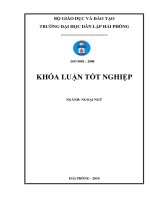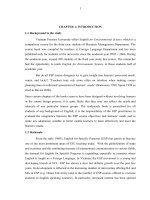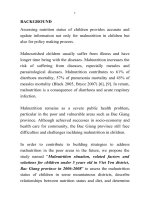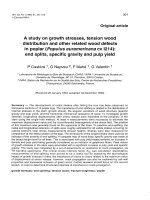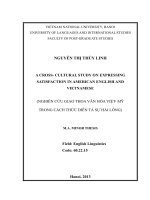STUDY ON EMPLOYEE SATISFACTION ABOUT SALARY, BONUS AND REMUNERATION POLICIES AT DONG THANH TECHNOLOGY CO , LTD (2)
Bạn đang xem bản rút gọn của tài liệu. Xem và tải ngay bản đầy đủ của tài liệu tại đây (628.97 KB, 119 trang )
DUY TAN UNIVERSITY
INTERNATIONAL SCHOOL
PSU DIVISION
---------------
UNDERGRADUATE THESIS
STUDY ON EMPLOYEE SATISFACTION ABOUT SALARY,
BONUS AND REMUNERATION POLICIES AT DONG
THANH TECHNOLOGY CO., LTD
MAJOR
: BUSINESS ADMINISTRATION
MENTOR
: LE THI KHANH LY
STUDENT
: HOANG THI NGOC TRANG
CLASS
: K24PSU-QTH4
ID NUMBER : 24202808170
Danang, May 2022
DISCLAIMER
I certify that the attached thesis is my original work. No other person’s work has
been used without due acknowledgement. Except where I have l clearly stated that I
have used some of the this material , it has not been presented by me for
examination in any other course or subject at this or any other institution.
I understand that the work submitted may be reproduced and/or communicated
for the purpose of detecting plagiarism. I understand that should this declaration be
false, I am libel to be penalized under the Duy Tan University regulations.
Da Nang, May 2022.
Hoàng Thị Ngọc Trang
ACKNOWLEDGEMENT
After studying and doing research at Duy Tan University, I have received
attention, help and encouragement from teachers, family, friends and colleagues.
Completing this thesis is an opportunity for me to express my respect and gratitude.
First and foremost, I want to express my hearfelt appreciation to my science
mentor, my mentor is Pham Thi Thuy Mien of Duy Tan University’s Faculty of
International Education, for spending so much time and enthusiasm in guiding,
support me, and accompany me throughout the process of learning and
implementing the thesis.
I’d like to express my gratitude to the faculty members of Duy Tan
University’s Faculty of International Education for their scientific and technical
assistance, as well as for sharing invaluable guidance on protocols, procedures, and
formalities when at school learning and writing.
I also would like to express my deep thanks to the Board of Directors, friends,
and colleagues for creating favorable conditions and supporting me in my work so
that I can participate in research and complete the thesis.
Finally, I’d like to express my heartfelt appreciation to my family members
who have always been there for me, inspired and helped me bothe physically and
mentally, and served as my fulcrum and inspiration in life, work and science study.
TABLE OF CONTENTS
LIST OF ABBREVIATIONS..................................................................................7
LIST OF TABLES...................................................................................................9
LIST OF FIGURE.................................................................................................12
CHAPTER 1: INTRODUCTION..........................................................................1
1.1 REASONS FOR CHOOSING A RESEARCH TOPIC........................................1
1.2 RESEARCH OBJECTIVES................................................................................2
1.3 SUBJECT AND SCOPE OF RESEARCH..........................................................3
1.4 RESEARCH METHODS....................................................................................3
1.5 SIGNIFICANCE OF THE STUDY.....................................................................4
CHAPTER 2: RESEARCH OVERVIEW.............................................................5
2.1 THEORETICAL BASIS OF SATISFACTION WITH THE POLICY OF
SALARY, BONUS AND REMUNERATION OF PERSONNEL.............................5
2.1.1 Theory of employee satisfaction.......................................................................5
2.1.2 Theory of salary, bonus and remuneration policies for personnel.....................6
2.2 2.2 MODEL OF PREVIOUS STUDY...............................................................12
2.2.1 Research by Nguyen Khac Hoan (2010).........................................................12
2.2.2 Research by Nguyen Thi Thuy Quynh (2012)................................................13
2.2.3 Research by Nguyen Thi Hong (2015)...........................................................14
2.2.4 Research by Vu Thuy Duong and Hoang Van Hai (2011)...............................15
2.3 SUMMARY OF RESEARCH MODELS..........................................................16
2.4 PROPOSED RESEARCH MODEL..................................................................17
2.4.1 Salary.............................................................................................................. 18
2.4.2 Bonus.............................................................................................................. 19
2.4.3 Allowances, subsidies & welfare....................................................................19
2.4.4 Compensation through work...........................................................................20
2.4.5 Compensation through work environment......................................................20
2.4.6 Employee satisfaction on salary, bonus and remuneration policies................21
CHAPTER 3: RESEARCH METHODS.............................................................22
3.1 COMPANY OVERVIEW..................................................................................22
3.1.1 Overview of the formation and development of the company........................22
3.1.2 Organizational structure and functions of each department............................24
3.1.3 Results of the company's production and business activities..........................27
3.1.4 Labor situation of the company.....................................................................30
3.1.5 Salary, bonus and remuneration policy of the company.................................32
3.2 3.2 CONSTRUCTION AND MEASUREMENT OF THE PROPOSED
RESEARCH VARIABLES.....................................................................................38
3.2.1 Salary.............................................................................................................. 38
3.2.2 Bonus.............................................................................................................. 39
3.2.3 Allowances, subsidies and welfare.................................................................39
3.2.4 Compensation through work...........................................................................40
3.2.5 Compensation through work environment......................................................41
3.2.6 Employee satisfaction on salary, bonus and remuneration policies................41
3.3 QUALITY RESEARCH....................................................................................42
3.3.1 Objectives of qualitative research...................................................................42
3.3.2 Design of qualitative research.........................................................................42
3.4 QUANLITIVE RESEARCH.............................................................................43
3.4.1 Objectives of qualitative research...................................................................43
3.4.2 Quantitative study design...............................................................................43
3.4.3 Information collection process........................................................................43
3.4.4 Sample size.....................................................................................................44
3.5 QUESTIONNAIRE...........................................................................................44
3.6 SOME METHODS OF DATA ANALYSIS.......................................................45
3.6.1 Descriptive statistics.......................................................................................45
3.6.2 Testing of Cronbach's Alpha scale..................................................................45
3.6.3 Factor exploratory analysis.............................................................................46
3.6.4 Build regression equation...............................................................................47
3.6.5 Test the research hypothesis............................................................................48
3.6.6 Check the correlation phenomenon of residuals.............................................48
CHAPTER 4: RESEARCH RESULTS................................................................50
4.1 QUALITATIVE RESEARCH RESULTS..........................................................50
4.2 SAMPLE DESCRIPTION.................................................................................50
4.2.1 Gender............................................................................................................51
4.2.2 Age.................................................................................................................52
4.2.3 Education level...............................................................................................53
4.2.4 Income............................................................................................................54
4.2.5 Test the relationship between gender and education level..............................55
4.2.6 Test the relationship between gender and age.................................................58
4.3 TESTING THE RELIABILITY OF THE RANGE WITH CRONBACH’S
ALPHA...................................................................................................................60
4.3.1 Cronbach's Alpha test for independent variables............................................61
4.3.2 Cronbach's Alpha test for the dependent variable "Employee satisfaction"....66
4.3.3 Summary after checking the reliability of Cronbach's Alpha..........................67
4.4 EFA FACTOR DISCOVERY ANALYSIS.........................................................67
4.4.1 Factor analysis (EFA) for the independent variable........................................68
4.4.2 Factor Analysis (EFA) for the dependent variable “Employee satisfaction”...71
4.5 MULTI-VARIABLE LINEAR REGRESSION ANALYSIS.............................73
4.5.1 Check the correlation matrix between the factors...........................................74
4.5.2 Testing of model fit (Adjusted R Square, ANOVA.........................................75
4.5.3 Test for autocorrelation of residuals (Autocorrelation)...................................76
4.5.4 Testing of regression coefficients and multicollinearity (Multiple Collinearity)
................................................................................................................................. 77
4.5.5 Testing the hypotheses of the research model.................................................78
4.5.6 Test the model's hypotheses............................................................................80
CHAPTER 5: CONCLUSIONS AND SOLUTIONS..........................................81
5.1 SUMMARY OF RESEARCH RESULTS.........................................................81
5.2 SOME PROPOSED SOLUTIONS TO IMPROVE EMPLOYEES
SATISFACTION ON SALARY, BONUS AND RECOMMENDATION POLICY
AT DONG THANH TECHNOLOGY CO., LTD....................................................83
5.2.1 Salary solution................................................................................................83
5.2.2 Bonus solution................................................................................................85
5.2.3. Solutions for Allowances, subsidies and welfare...........................................87
5.2.4. Solutions on compensation through work......................................................89
5.2.5 Solutions on compensation through work environment..................................90
5.3 MEANING OF THE STUDY...........................................................................92
5.4 LIMITATIONS OF THE RESEARCH..............................................................92
5.5 FURTHER RESEARCH DIRECTIONS...........................................................93
BIBLIOGRAPHY.................................................................................................94
APPENDICES.......................................................................................................95
Appendix 1..............................................................................................................95
Appendix 2..............................................................................................................98
LIST OF ABBREVIATIONS
No
1
2
Abbreviation
HR
SPSS
Mean
Human Resource
Statistical Products for the Social Services
LIST OF TABLES
No
2.1
2.2
3.1
3.2
3.3
3.4
3.5
3.6
3.7
3.8
3.9
3.10
4.1
4.2
4.3
4.4
4.5
4.6
4.7
4.8
4.9
Name
Summary of proposed research models
Scale of proposed research variables
Production and business situation of Dong Thanh Engineering
Co., Ltd from 2019 - 2021
Table of size and labor structure of the Company in 2019-2021
Business trip allowance
Regulations on accommodation allowances for employees who go
on a business trip to find hotels by themselves
Scale for the factor variable “Salary”
Scale for the factor variable “Bonus”
Scale for the factor variable “Allowances, subsidies and welfare”
Scale for the factor variable “Compensation through work”
Scale for the factor variable “Compensation through work
environment”
Scale for the factor variable “Employee satisfaction on salary,
bonus and remuneration policies”
Sample Descriptive Statistics
Descriptive analysis of gender factors
Descriptive analysis of age group factors
Descriptive analysis of factors of education level
Descriptive analysis of income factors
Testing the relationship between gender and education level
Pearson Chi-Square table of testing the relationship between
gender and education level
Testing the relationship between Gender and Age
Pearson Chi-Square table of testing the relationship between
gender and age
4.10 Cronbach's Alpha Test of the Salary Factor
4.11 Cronbach's Alpha Test of Bonus factor
Cronbach's Alpha test of the factor Allowances, subsidies and
4.12
welfare
4.13 Cronbach's Alpha test of the factor Compensation through work
Cronbach's Alpha test of the Compensation through work
4.14
environment
4.15 Test Cronbach's Alpha factor Employee satisfaction
4.16 KMO-EFA coefficient of employee satisfaction component
Page
16
18
27
30
36
37
38
39
40
40
41
42
50
51
52
53
54
55
56
58
59
61
62
63
64
65
66
68
4.17
4.18
4.19
4.20
4.21
4.22
4.23
4.24
4.25
Total extracted variance of the employee satisfaction component
EFA
Factor loading EFA of employee satisfaction component
KMO-EFA coefficient of employee satisfaction factor
Total variance extracted of employee satisfaction factor
Factor loading EFA of the factor Employee satisfaction
Test results of correlation coefficient r
R Square analysis of the fit of the regression equation
ANOVA analysis of the fit of the regression equation
Statistical analysis of residual autocorrelation of the regression
equation
4.26 Regression coefficient of employee satisfaction factors
Coefficients of regression model to test hypotheses of research
4.27
model
4.28 Order of influence of factors on employee satisfaction by %
Hypothesis testing and statistics on the influence of factors on
4.29
employee satisfaction on salary, bonus and remuneration policies
5.1 Descriptive statistics of the factor “Salary”
5.2 Descriptive statistics of the factor “Bonus”
Descriptive statistics of the factor “Allowances, subsidies and
5.3
welfare”
5.4 Descriptive statistics of the factor “Compensation through work”
Descriptive statistics of the factor “Compensationthrough working
5.5
environment”
69
70
71
72
73
74
75
75
76
77
78
79
80
83
85
87
89
90
LIST OF FIGURE
ST
Tên
Trang
T
2.1
2.2
2.3
2.4
2.5
Research model of Nguyen Khac Hoan (2010)
Research model of Nguyen Thi Thuy Quynh (2012)
Research model of Nguyen Thi Hong (2015)
Research model of Vu Thuy Duong and Hoang Van Hai (2011)
Research model proposes employee satisfaction about salary,
12
13
14
15
17
3.1
4.1
4.2
4.3
4.4
4.5
4.6
bonus and remuneration policies
Organization chart of Dong Thanh Engineering Co., Ltd
Structure of Gende
Structure of Age
Structure of education level
Structure by income
Graph of the relationship between gender and education level
Sex and age relationship graph
24
50
51
52
53
56
59
1
CHAPTER 1
INTRODUCTION
1.1 REASONS FOR CHOOSING A RESEARCH TOPIC
In Vietnam, the engineering industry plays a very important role in the
economy, has strong development potential and is considered one of the key
industries on the industrialization race. Modernization aims to improve science and
technology, shorten the technical gap between developing countries. This is an
extremely broad industry group and always has the highest demand for recruiting,
creates jobs for a large workforce, contributes to poverty alleviation, and at the
same time contributes a significant source of revenue to the national budget.
The issue of salary, bonus and personnel treatment is certainly not strange to
those who have been participating in the labor market. This is one of the
important elements of Human Resource Management; is an effective human
resource management and development tool of enterprises. A suitable policy of
salary, bonus and remuneration will be the motivation and inspiration for
employees to devote themselves to work, thereby improving work efficiency and
productivity. According to a survey by Ernst & Young, the remuneration factor is
one of the top three reasons why employees leave their positions (over 70%),
which demonstrating that salary, bonus and remuneration policies contribute to
helping businesses maintain the stability of human resources because this is one
of the ways for enterprises to attract personnel, retain talented employees to
work, minimize job abandonment, thereby improving efficiency of corporate
governance functions. In addition, the salary, bonus and remuneration regimes
for personnel have strong impacts on the development of society, ensure the
spiritual and material life for employees, improve the quality of life, and reduce
poverty. social problems, maintaining social stability. At the same time, the work
efficiency that employees create for businesses also contributes to a certain
extent to the national economy, improving the socio-economic life of the
country. Nowadays, the salary, bonus and remuneration policies are applied
2
flexibly by enterprises, depending on the vision, business strategic goals and
especially the human resource policy that enterprises pursue.
Studies have shown that employees’ satisfaction has a positive effect on their
loyalty to organizations (Luddy, 2005). The study of employees’ satisfaction helps
managers plan a good employee retention and development policies, make
employees more satisfied and limit the phenomenon of "brain drain". From there,
leaders can improve, amend and supplement human resource policies in the
company within the allowable framework to increase work efficiency and increase
employee engagement with the organization.
Over the past 3 years, Dong Thanh Technology Co., Ltd, with stable
development, has successfully laid the foundation and made leaps and bounds in
many aspects from scale, scope of activities to product quality, service. In order to
accomplish so, the company needs to have a high-quality workforce. According to
the research, every year, a large number of employees quit their jobs, which has a
significant impact on work productivity as well as costly and time to recruit and retrain personnel to compensate for the number of employees resigning. As mentioned
above, the salary, bonus and remuneration policy is one of the top reasons for which
employees decide to pursue the job or give up. In order to assess the employee's
satisfaction about salary, bonus and remuneration, I boldly choose the topic "Study
on employee satisfaction about salary, bonus and remuneration policies at Dong
Thanh Technology Co., Ltd" as graduation thesis.
1.2 RESEARCH OBJECTIVES
Systematizing theories and models on employee satisfaction with the company's
compensation and reward policy, thereby building a research model to assess the
employees’ satisfaction with the compensation and reward policy towards Dong
Thanh Technology Co., Ltd.
Determining the factors that affect the employee's satisfaction with the salary,
bonus and remuneration policy of Dong Thanh Technology Co., Ltd.
3
Considering
the
satisfaction
level
of
employees'
compensation
and
compensation policies with respect to factors and general satisfaction.
Proposing a number of solutions for the company and managers to improve
employee satisfaction with the remuneration and remuneration policy, contributing
to improving the efficiency of the Company's human resource management of Dong
Thanh Technology Co., Ltd.
1.3 SUBJECT AND SCOPE OF RESEARCH
Research subjects
- Subject of research: Satisfaction with salary, bonus and remuneration policies
at Dong Thanh Technology Co., Ltd.
- Survey subjects: employees at Dong Thanh Technology Co., Ltd.
Research period: The topic was studied during the internship period from
February 14, 2022 to May 20, 2022.
Research space: Dong Thanh Technology Co., Ltd..
1.4 RESEARCH METHODS
Qualitative research
- Satisfaction survey: Employees’ satisfaction about salary, bonus and
remuneration policies at Dong Thanh Technology Co., Ltd.
- Collected by survey questions
- Direct interviews with employees who are working directly at the company.
- Search for sample information available from domestic and foreign research
papers.
Quantitative research
Prepare survey questionnaires and collect data. After collecting specific data
and content, conducting tests, analysis, synthesis and comparison through Excel,
SPSS software.
4
1.5 SIGNIFICANCE OF THE STUDY
Thesis consists of 5 chapters
Chapter 1: Introduction
Chapter 2: Research overview
Chapter 3: Research Methods
Chapter 4: Research results
Chapter 5: Conclusion and solutions.
5
CHAPTER 2
RESEARCH OVERVIEW
2.1 THEORETICAL BASIS OF SATISFACTION WITH THE POLICY OF
SALARY, BONUS AND REMUNERATION OF PERSONNEL
2.1.1 Theory of employee satisfaction
Employee satisfaction is a concept that has not been agreed by researchers from
different perspectives.
Maslow's (1943) need scale theory states that when employees meet the needs
from low to high. Since then, Kusku (2003) suggests that employee satisfaction
reflects the needs and wants of employees are met and the extent to which
employees perceive their work. Wright and Kim (2004) also suggested that
employee satisfaction at work is the match between what employees want from the
job and what they feel from the job.
Some researchers believe that employee satisfaction is the employee's positive
emotional state with work expressed through their behavior and beliefs (Vroom,
1964; Locke, 1976; Quinn and Staines, 197). ; Weiss et al., 1967).
Employee satisfaction would be defined as the amount of generally positive or
emotional influence an individual has on his or her job. (Fieldman and Arnold).
Although there are many different definitions of employee satisfaction, they are
generally defined in two aspects: general job satisfaction and satisfaction obtained
when employees have a feeling of enjoyment and comfort. and show positive
responses to aspects of their work.
6
2.1.2 Theory of salary, bonus and remuneration policies for personnel
2.1.2.1 Concepts, forms and roles of salary, bonus and remuneration for personnel
Salary
- Concept:
Salary is an important aggregate economic category in the commodityproducing economy, it represents the remuneration that workers receive after a
period of working for the enterprise or the owner based on the amount of money. ,
the quality of labor that that person spends and the production and business results
of his/her unit.
According to the International Labor Organization (LLO) “Salary are
remuneration or income. whatever the name or crystal, which is expressed in terms
and is fixed by the agreement between the employer and the employee, or by
national law or regulation, established by the employer payable to a worker under a
written or oral contract of employment, to a worker performed or to be performed,
or for services performed or to be performed".
According to Article 55 of the Labor Code of our country: "The employee's
salary is agreed upon by the two parties in the contract and is paid according to
labor productivity, quality and work efficiency". not lower than the minimum salary
prescribed by the State.
Salary is formed from three components: basic salary (accounting for 70-80%
of salary), allowances, subsidizes and bonuses.
- Role: Salary plays an important role for employees and the whole business.
They have the effect of compensating for labor for employees, encourage
employees to work with peace of mind. For enterprises, salary is considered a part
of production costs, an important lever to improve business efficiency of
enterprises. Organizing salarys in a fair and reasonable enterprise will contribute to
maintaining, consolidating and developing its labor force.
Bonus
- Concept: Bonus is actually an additional amount of salary in order to better
grasp the principle of distribution according to labor and improve efficiency in
7
production and business of enterprises. Bonus is the amount of money that the
business pays to employees because they have contributed achievements beyond the
level specified by the business.
- Bonus forms: Bonuses according to national holidays; Bonuses based on
business results (quarterly or annually); Bonus according to sales revenue
(Monthly); Bonuses for saving materials; Bonuses for technical innovation
initiatives; Bonus for completing the schedule earlier than prescribed; Bonuses due
to good quality productivity; Bonus for finding a place to supply, consume, sign a
new contract; Bonus for ensuring working day…
- Role: Bonus acts as a material incentive for employees in the working process,
has a very positive effect for them to strive to perform better, thereby improving
labor productivity and product quality. products, shortening working time. Bonuses
together with base salary make up the main cash earnings of employees. Therefore,
bonuses also contribute to helping employees satisfy the material and spiritual
needs of themselves and their families to a higher degree. To some extent, bonuses
are more powerful incentives than salarys.
Human resources treatment
- Concept:
Employee compensation is the process of taking care of employees' material
and spiritual lives so that they can well complete their assigned tasks and thereby
contribute to the accomplishment of the enterprise's goals.
Human resource compensation is a process in which every manager is
responsible for employee compensation, from formulating compensation policies to
organizing
and
implementing
remuneration
in
the
enterprise.
Personnel
remuneration must aim at satisfying the physical and mental needs of employees.
- Form:
Financial: Indirect (insurance; allowance; welfare; paid absence); Direct
(worker salary; monthly salary; commission; bonus ...)
Non-financial: The job itself (interesting task; striving; responsibility;
opportunity to be recognized by superiors; feeling of accomplishment; opportunity
8
for promotion); Working environment (comfortable environment; flexible hours,
suitable status symbols, reasonable policies; skillful testing; working online...)
- Role
For employees, human resource treatment creates conditions for employees to
improve their material and spiritual life. Thus, new employees can gain motivation
to work, achieve the highest efficiency and have more attachment and confidence in
the job and the enterprise.
For enterprises, human resource treatment is a sufficient condition to improve
the quality and efficiency of production and business activities of each enterprise,
contributing to maintaining a stable and qualified human resource, thereby ensuring
the business process of enterprises. Human resource benefits help improve the
efficiency of other human resource management functions in the enterprise, in order
to create a humanistic cultural environment in the enterprise, helping to strengthen
and develop the spirit of the enterprise and employees.
For society, human resource compensation helps maintain stable and quality
human resources for the society, contributes to ensuring socio-economic stability
and creates favorable conditions for the implementation of the development
strategy. human development of each country.
2.1.2.2 Factors affecting the policy of salary, bonus and remuneration of
personnel
Any employee working for an enterprise wants to receive a salary, bonus and
remuneration commensurate with their ability and competitive with the market.
Therefore, enterprises need to analyze all the factors affecting to make a specific
salary, bonus and remuneration policy for employees in a suitable and correct way.
If we ignore the study of these factors, the salary, bonus and remuneration system
will be subjective and biased. In general, looking at the chart below, we will see the
four most important factors to consider. These are four factors: (1) the company
environment, (2) the labor market, (3) the job itself, and (4) the employee himself.
Specifically:
9
Company environment
- Company policy: If a company wants to attract many talents, the salary, bonus
and remuneration policy must be higher, more complete and have more benefits for
employees than other companies.
- Company culture: Company culture is one of the important prerequisites in
ensuring the existence and development of a business. It greatly affects the way
employees are selected, the attitudes of superiors and subordinates, etc., thus also
affecting the salary, bonus and remuneration regimes for employees. In companies
with a long cultural tradition, employees are really cared for, and the remuneration
is fair, satisfactory and reasonable.
- Business efficiency: Normally, enterprises with large resources, especially
financial resources, good business situation, such enterprises will perform better in
remuneration, salary and bonus than non-business enterprises. effective and
inefficient.
- Organizational structure: If the company has many managers, the salary
structure is detrimental to employees because senior managers do not go in-depth,
go closely to employees, greatly affect the money structure salary.
Labor market:
- Salary factor: The fierce competition in the labor market will inevitably lead
to an unstable supply - demand situation. This is an important factor that directly
affects the remuneration of the company. Leaders will rely on changes in the labor
market to offer appropriate remuneration packages to attract and retain highly
qualified employees. Special attention should be paid to the general level of salary,
bonus, welfare, allowance, ... in an industry or a business field in order to have a
reasonable remuneration regime to ensure competitiveness in order to attract,
Maintain human resources in the enterprise.
- Cost of living: Enterprises need to pay more attention to the daily life of
employees in order to have a remuneration regime to ensure living expenses for
employees. With a market with a lot of fluctuations in prices like ours, businesses
need to quickly adjust the salary fund and remuneration regime accordingly and
10
ensure the employees' lives so that they can devote their energy and intelligence for
business.
- Economy: The state of economic growth or recession directly affects the
business activities of enterprises, thereby affecting the financial remuneration of
enterprises.
- Society: Society will put pressure on some businesses not to arbitrarily raise
salarys and increase selling prices. Because they do not want salarys, benefits, etc.
to increase, this will affect the price of products and services.
- Law: In any society, the law has specific regulations to protect employees:
working time, rest time, employee protection policies, salary regulations. minimum
labor safety measures... Enterprises, when offering a remuneration regime, must
comply with the provisions of the law and be responsible before the law for their
regime.
Employees themselves:
- Competence and achievements: People with high qualifications and better
performance than ordinary workers will enjoy higher remuneration.
- Experience and seniority: Previously, people with seniority and high
experience were recommended for promotion, salary increase or higher
remuneration. Currently, this view is gradually changing, seniority is only one of the
factors considering salary, and experience is a factor affecting salary and benefits.
Most companies rely on this factor to select employees and consider salary and
benefits.
- Loyalty: Loyal employees who have worked for a long time at the company
enjoy higher remuneration than others, mainly in the form of benefits. Their paid
leave will be longer than others.
- Potential of employees: A good leader must know how to steer, lead and guide
employees to develop their potential, this is not something that every leader can do.
One way is to offer a high salary and more attractive benefits than other employees.
When superiors care about them, such employees will find themselves recognized
11
for their contributions and will become more and more confident, devoting their
abilities to the common purpose of the Company.
The work itself:
- Working conditions: Depending on working conditions, employees are entitled
to remuneration. employees working in difficult and hazardous conditions, in
remote areas... are entitled to higher-than-average remuneration and in addition to
regional allowances…
- Nature of work: in enterprises, jobs of different nature will have different
salaries and bonuses. For important, dangerous and toxic jobs (police, working in
toxic chemical factories, in mines, under the sea, ...) requiring highly skilled
employees, Good health will receive a higher remuneration than employees doing
ordinary jobs. When offering remuneration to employees, administrators will base
on the nature of work of each employee and group of employees to have appropriate
and fair regimes in the enterprise.
- Working conditions: As mentioned above, in different working conditions, the
salary and bonus will also be different. if the employee works in an environment
with difficult, hazardous and dangerous conditions, the employee will enjoy a
higher salary and bonus than the employee working in normal conditions. Often
employees work in remote areas, lacking facilities and technical equipment... in
addition to high remuneration, employees also receive regional allowances.
12
2.2 2.2 MODEL OF PREVIOUS STUDY
2.2.1 Research by Nguyen Khac Hoan (2010)
In the research by Nguyen Khac Hoan on “Các yếu tố ảnh hưởng đến động lực
làm việc của nhân viên áp dụng tại Ngân hàng Thương mại Cổ Phần Á Châu, chi
nhánh Huế”, quoted in Hue University Magazine No. 60 (2010) pointed out 5
factors affecting employee's work motivation: Compensation through work
environment; salary and benefits; work arrangement; compensation through work
and career prospects. In terms of advantages, through studying this document, I see
that the author has made an assessment of the elements of the model, and at the
same time focused on providing solutions to the problems facing businesses.
research.
Compensation through work environment
Salary bonus and welfare
Work arrangement
Employee
motivation
Compensation through work
Career prospects
Figure 2.1: Research model of Nguyen Khac Hoan (2010)
13
2.2.2 Research by Nguyen Thi Thuy Quynh (2012)
In the study by Nguyen Thi Thuy Quynh (2012) on “Sự hài lòng của nhân viên
Eximbank chi nhánh Đà Nẵng” quoted in the Scientific Journal of Hong Duc
University, pointed out 7 factors: compensation through work; promotion training;
leader; colleague; salary, bonus; welfare; compensation through work environment
affects employee satisfaction.
Compensation through work
Promotion training
Leader
Partner
Employee
satisfaction
Salary, bonus
Welfare
Compensation through work environment
Figure 2.2: Research model of Nguyen Thi Thuy Quynh (2012)
14
2.2.3 Research by Nguyen Thi Hong (2015)
Research by Nguyen Thi Hong is quoted in Hue University Magazine No. 50
(2015) with the title “Đánh giá sự hài lòng của người lao động gián tiếp về chính
sách đãi ngộ tài chính của Công ty TNHH Triệu Mạnh”. This topic has more
advantages than those mentioned above because it used a scale of 4 options to avoid
the trend of averaging, and proposed a model consisting of 5 factors affecting the
level of satisfaction. employees' satisfaction is: salary; bonus; allowances, subsidize
and welfare; compensation through work and compensation through work
environment. In which, the regression results show the salary and bonus factors;
welfare factor; The factor of compensation through work and the factor of
compensation through the working environment are the four most important factors
and are proposed by the author to be the top priority to solve.
Salary
Bonus
Allowances, subsidize and welfare
Satisfaction rating
Compensation through work
Compensation through work environment
Figure 2.3: Research model of Nguyen Thi Hong (2015)
